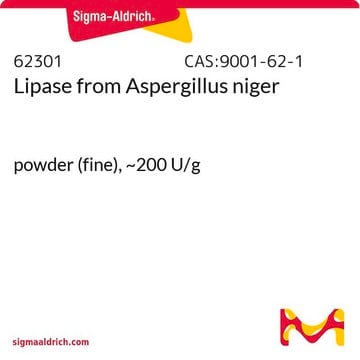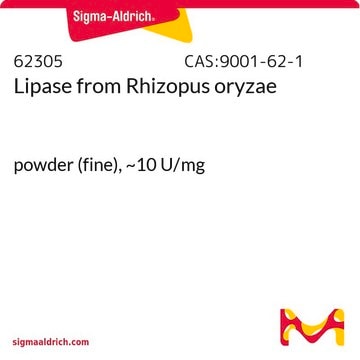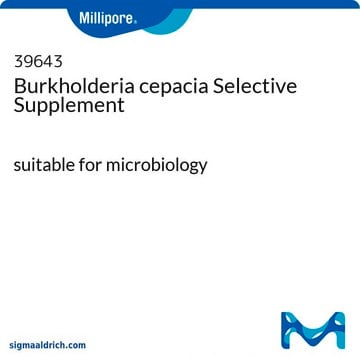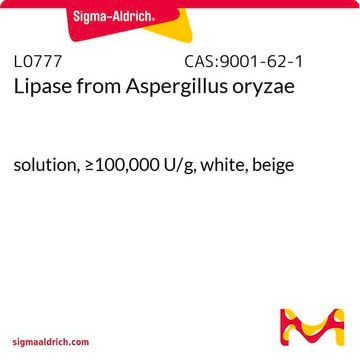62316
Lipase from Candida rugosa
powder, yellow-brown, ≥2 U/mg
Synonyme(s) :
CCL
About This Item
Produits recommandés
Source biologique
fungus (Candida rugosa)
Niveau de qualité
Forme
powder
Activité spécifique
≥2 U/mg
Poids mol.
Mr ~67000
Conditions de stockage
dry at room temperature
Concentration
≤100%
Technique(s)
analytical sample preparation: suitable
Couleur
yellow-brown
Plage de pH
6.5—7.5 (0.01 g/L)
Solubilité
water: slightly soluble
Application(s)
sample preservation
Température de stockage
2-8°C
InChI
1S/C11H9N3O2.Na/c15-8-4-5-9(10(16)7-8)13-14-11-3-1-2-6-12-11;/h1-7,16H,(H,12,14);/q;+1/b13-9-;
Clé InChI
QWZUIMCIEOCSJF-CHHCPSLASA-N
Informations sur le gène
fungus ... LAP1(2544)
Vous recherchez des produits similaires ? Visite Guide de comparaison des produits
Description générale
The lipase enzyme is a naturally occurring enzyme present in both the stomach and pancreatic juice. It is expressed and active in various tissues. For instance, hepatic lipases are found in the liver, hormone-sensitive lipases in adipocytes, lipoprotein lipase on the vascular endothelial surface, and pancreatic lipase in the small intestine. These lipases are classified within the alpha/beta-hydrolase fold superfamily of enzymes.
Application
Actions biochimiques/physiologiques
Définition de l'unité
Mention d'avertissement
Danger
Mentions de danger
Conseils de prudence
Classification des risques
Resp. Sens. 1
Code de la classe de stockage
11 - Combustible Solids
Classe de danger pour l'eau (WGK)
WGK 1
Point d'éclair (°F)
Not applicable
Point d'éclair (°C)
Not applicable
Équipement de protection individuelle
Eyeshields, Gloves, type N95 (US)
Certificats d'analyse (COA)
Recherchez un Certificats d'analyse (COA) en saisissant le numéro de lot du produit. Les numéros de lot figurent sur l'étiquette du produit après les mots "Lot" ou "Batch".
Déjà en possession de ce produit ?
Retrouvez la documentation relative aux produits que vous avez récemment achetés dans la Bibliothèque de documents.
Les clients ont également consulté
Notre équipe de scientifiques dispose d'une expérience dans tous les secteurs de la recherche, notamment en sciences de la vie, science des matériaux, synthèse chimique, chromatographie, analyse et dans de nombreux autres domaines..
Contacter notre Service technique











